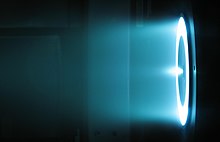From Wikipedia, the free encyclopedia
For vehicles other than spacecraft that are propelled by electric means, see Electric vehicle.
Contents
History
The idea of electric propulsion for spacecraft dates back to 1911, introduced in a publication by Konstantin Tsiolkovsky.[5] Earlier, Robert Goddard had noted such a possibility in his personal notebook.[6]The first in-space demonstration of electric propulsion was an ion engine carried on board the SERT-1 (Space Electric Rocket Test) spacecraft, launched on 20 July 1964.
Types of electric propulsion
Ion/plasma drives
Main article: Ion thruster
This type of rocket-like reaction engine uses electric energy to obtain thrust from propellant carried with the vehicle. Unlike rocket engines, these kinds of engines do not necessarily have rocket nozzles, and thus many types are not considered true rockets.
Electric propulsion thrusters for spacecraft may be grouped in three
families based on the type of force used to accelerate the ions of the
plasma:Electrostatic
If the acceleration is caused mainly by the Coulomb force (i.e. application of a static electric field in the direction of the acceleration) the device is considered electrostatic.- Electrostatic ion thruster (Ion Bombardment)
- Colloid ion thruster
- Contact ion thruster
- Field Emission Electric Propulsion
- Microwave (Radiofrequency) ion thruster
- Plasma separator ion thruster
- Radioisotopic ion thruster
- Nano-particle field extraction thruster
- Hall effect thruster
Electrothermal
The electrothermal category groups the devices where electromagnetic fields are used to generate a plasma to increase the temperature of the bulk propellant. The thermal energy imparted to the propellant gas is then converted into kinetic energy by a nozzle of either solid material or magnetic fields. Low molecular weight gases (e.g. hydrogen, helium, ammonia) are preferred propellants for this kind of system.An electrothermal engine uses a nozzle to convert the heat of a gas into the linear motion of its molecules so it is a true rocket even though the energy producing the heat comes from an external source.
Performance of electrothermal systems in terms of specific impulse (Isp) is somewhat modest (500 to ~1000 seconds), but exceeds that of cold gas thrusters, monopropellant rockets, and even most bipropellant rockets. In the USSR, electrothermal engines were used since 1971; the Soviet "Meteor-3", "Meteor-Priroda", "Resurs-O" satellite series and the Russian "Elektro" satellite are equipped with them.[7] Electrothermal systems by Aerojet (MR-510) are currently used on Lockheed Martin A2100 satellites using hydrazine as a propellant.
Electromagnetic
If ions are accelerated either by the Lorentz force or by the effect of an electromagnetic fields where the electric field is not in the direction of the acceleration, the device is considered electromagnetic.- Electrodeless plasma thruster
- MPD thruster
- Pulsed inductive thruster
- Pulsed plasma thruster
- Helicon Double Layer Thruster
- VASIMR
- Quantum Vacuum Plasma Thruster
Other
Non-ion drives
Electrodynamic tether
Main article: electrodynamic tether
Electrodynamic tethers are long conducting wires, such as one deployed from a tether satellite, which can operate on electromagnetic principles as generators, by converting their kinetic energy to electric energy, or as motors, converting electric energy to kinetic energy.[8]
Electric potential is generated across a conductive tether by its
motion through the Earth's magnetic field. The choice of the metal conductor to be used in an electrodynamic tether is determined by a variety of factors. Primary factors usually include high electrical conductivity, and low density. Secondary factors, depending on the application, include cost, strength, and melting point.Steady vs. unsteady
Electric propulsion systems can also be characterized as either steady (continuous firing for a prescribed duration) or unsteady (pulsed firings accumulating to a desired impulse). However, these classifications are not unique to electric propulsion systems and can be applied to all types of propulsion engines.Dynamic properties
Further information: Reaction engine#Energy use
Electrically-powered rocket engines provide lower thrust compared to chemical rockets by several orders of magnitude because of the limited electrical power possible to provide in a spacecraft.[2]
A chemical rocket imparts energy to the combustion products directly,
whereas an electrical system requires several steps. However, the high
velocity and lower reaction mass
expended for the same thrust allows electric rockets to run for a long
time. This differs from the typical chemical-powered spacecraft, where
the engines run only in short intervals of time, while the spacecraft
mostly follows an inertial trajectory.
When near a planet, low-thrust propulsion may not offset the
gravitational attraction of the planet. An electric rocket engine cannot
provide enough thrust to lift the vehicle from a planet's surface, but a
low thrust applied for a long interval can allow a spacecraft to
manueuver near a planet.Possible uses in the outer Solar System
| This section requires expansion. (April 2013) |
See also
- Magnetic sail, a proposed system powered by solar wind from the Sun or any star
- List of spacecraft with electric propulsion, a list of past and proposed spacecraft which used electric propulsion

No comments:
Post a Comment